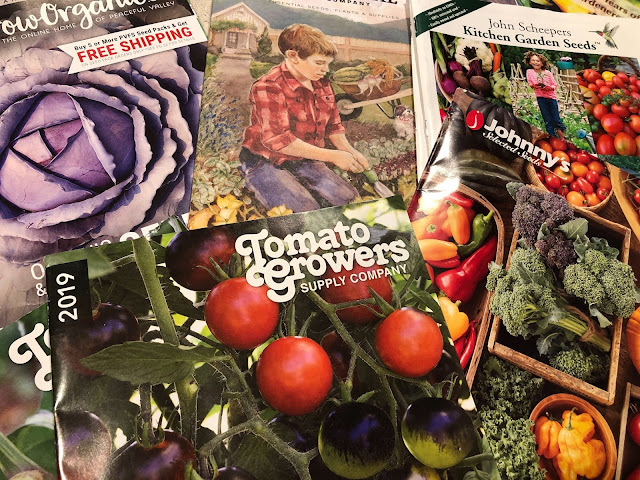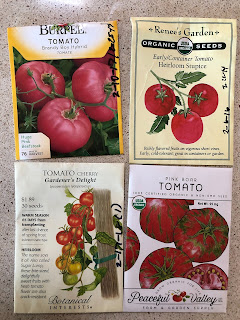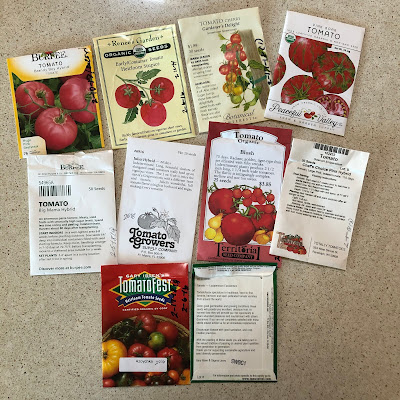
|
|
These are some of the seed catalogs piled up on my desk right now. (Photos: Kathy Morrison)
|
Catalogs can be seductive lures for seed buyers
Do you have a favorite seed catalog for tomatoes? I don't rely on just one, but I often start the season by looking through the
Tomato Growers Supply Co.
catalog, just to see what's new and to enjoy all the gorgeous full-color pictures of perfect tomatoes.
This year's catalog cover features one of those eye-grabbing indigo tomatoes, Midnight Snack Hybrid. I grew something similar when these were first hitting the market -- a gift plant from a friend -- and wasn't impressed with the flavor. But there's no denying they get people's attention.
A few of the varieties marked by TGSC as New! are ones I've tried in the past, from other sources, including Heatmaster, Jetsetter and Husky Red. (Jetsetter is good, but I like other early varieties better, if you're interested.) One intriguing offering is Early First Prize. Since the original First Prize is a Tomato Growers exclusive, and an excellent tomato, I might get this new one for next year. I already have a long list to grow this season.
When I was new to tomato seed starting, I'd order four to seven seed packets per catalog, from
Burpee Seeds
,
Totally Tomatoes
,
Territorial Seed
,
Nichols Garden Nursery
, and
Seeds of Change
, in addition to Tomato Growers. Later I discovered the overwhelming collection at
Baker Creek Heirloom Seeds
.
Online access has added
Peaceful Valley
,
TomatoFest
,
Renee's Garden
and
Wild Boar Farms
to my shopping list -- a looking list, really. (Renee's can be found at some of the nurseries around the area but my closest source, OSH, has closed.) Botanical Interests and Ferry-Morse seeds also are sold at local hardware and big box stores, along with Burpee, of course.
Yes, I'm more selective these days, primarily because I've figured out what grows well in the Sacramento region and in my garden in particular, but also because I never use up a package of seeds in one year. I've traded seeds with other gardeners, but we're more likely to trade seedlings.

|
|
These are the most helpful seed packets in
my current collection, with a photo or artwork
of the
variety, plus description and,
somewhere on the
package, the year packed.
|
Also, some of the seed companies aren't clued into California planting dates and send along the packages when they get to it -- which might be too late for us. In those cases, I just hang onto the seeds for next year and try to remember not to order from that company again. (My observation: The West Coast companies are better at shipping quickly. Wild Boar Farms and Peaceful Valley, in Napa County and Grass Valley, respectively, are the closest to us.)
If you're new to tomato seed starting, be aware of the code words buried in the descriptions of the seed varieties. "Vigorous" means you'd better give it plenty of room and your sturdiest cage. "Flavor worth waiting for" means it might, just might, produce a crop before fall. Any variety that promises "a profusion of tiny tomatoes" will

|
|
From most helpful package, Burpee "retail" version, top left,
to
least helpful,
TomatoFest, bottom row. TomatoFest's front and back are
the same
for all
varieties, except for the little sticker on front.
Burpee's "order" version
packet, interestingly, has no photo.
|
wear you out with picking.
Here are a few more:
-- "Sometimes their shape is a little rough." You won't be able to get a good slice from it.
-- "Compact, perfect for containers." A very slow grower.
-- "Early season, cold tolerant." It'll likely die early, too, if grown in the Sacramento flatlands.
-- "Intriguing flavor." After tasting the first one you won't know what to do with it.
-- "Unusual color." Not good for sharing. (Your non-gardener friends want red tomatoes. Trust me.)
-- "Sets well in heat." Not our heat.
So your seed order arrives -- hurray! But before you open the packages, make sure there's a date on them. The most helpful seed packages will say somewhere "Packed for 2019. Sell by 12/31/19." If there's no date -- I'm talking about you, Tomato Growers and TomatoFest -- write the year on it immediately. This will help in 2020 or later when you try to remember whether those seeds are still usable.
I also write on the package the date the seeds were started, so I can tell if I skipped a year. In some cases the seed company uses the same package for every variety, meaning no specific photo or artwork or even a description (TomatoFest again). So don't be afraid to write all over that package. You'll thank yourself later.


